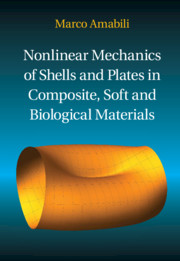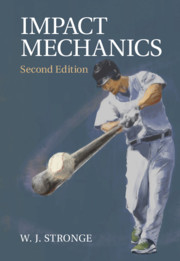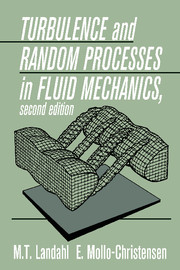Refine search
Actions for selected content:
8124 results in Fluid dynamics and solid mechanics
3 - Single Degree-of-Freedom Systems: Governing Equations
-
- Book:
- Vibrations
- Published online:
- 12 December 2018
- Print publication:
- 01 November 2018, pp 76-147
-
- Chapter
- Export citation
12 - Effect of Boundary Conditions on Large-Amplitude Vibrations of Circular Cylindrical Shells
-
- Book:
- Nonlinear Mechanics of Shells and Plates in Composite, Soft and Biological Materials
- Published online:
- 25 October 2018
- Print publication:
- 01 November 2018, pp 484-491
-
- Chapter
- Export citation
Preface to the Third Edition
-
- Book:
- Vibrations
- Published online:
- 12 December 2018
- Print publication:
- 01 November 2018, pp xxiii-xxviii
-
- Chapter
- Export citation
4 - Nonlinear Shell Theory with Thickness Deformation
-
- Book:
- Nonlinear Mechanics of Shells and Plates in Composite, Soft and Biological Materials
- Published online:
- 25 October 2018
- Print publication:
- 01 November 2018, pp 124-150
-
- Chapter
- Export citation
THE TWO-TRAIN SEPARATION PROBLEM ON LEVEL TRACK WITH DISCRETE CONTROL
- Part of
-
- Journal:
- The ANZIAM Journal / Volume 60 / Issue 2 / October 2018
- Published online by Cambridge University Press:
- 29 October 2018, pp. 137-174
-
- Article
-
- You have access
- Export citation

Nonlinear Mechanics of Shells and Plates in Composite, Soft and Biological Materials
-
- Published online:
- 25 October 2018
- Print publication:
- 01 November 2018

Knowledge Driven Development
- Bridging Waterfall and Agile Methodologies
-
- Published online:
- 20 October 2018
- Print publication:
- 08 March 2018

Impact Mechanics
-
- Published online:
- 19 October 2018
- Print publication:
- 15 November 2018

Turbulence and Random Processes in Fluid Mechanics
-
- Published online:
- 12 October 2018
- Print publication:
- 25 September 1992
-
- Textbook
- Export citation
1 - Formulating Geodynamic Model Problems: Three Case Studies
-
- Book:
- Theoretical Mantle Dynamics
- Published online:
- 20 September 2018
- Print publication:
- 04 October 2018, pp 1-8
-
- Chapter
- Export citation
11 - Convection in More Realistic Systems
-
- Book:
- Theoretical Mantle Dynamics
- Published online:
- 20 September 2018
- Print publication:
- 04 October 2018, pp 219-240
-
- Chapter
- Export citation
Index
-
- Book:
- Theoretical Mantle Dynamics
- Published online:
- 20 September 2018
- Print publication:
- 04 October 2018, pp 310-314
-
- Chapter
- Export citation
Dedication
-
- Book:
- Theoretical Mantle Dynamics
- Published online:
- 20 September 2018
- Print publication:
- 04 October 2018, pp v-vi
-
- Chapter
- Export citation
Contents
-
- Book:
- Theoretical Mantle Dynamics
- Published online:
- 20 September 2018
- Print publication:
- 04 October 2018, pp vii-x
-
- Chapter
- Export citation
Preface
-
- Book:
- Theoretical Mantle Dynamics
- Published online:
- 20 September 2018
- Print publication:
- 04 October 2018, pp xi-xiv
-
- Chapter
- Export citation
12 - Solutions to Exercises
-
- Book:
- Theoretical Mantle Dynamics
- Published online:
- 20 September 2018
- Print publication:
- 04 October 2018, pp 241-291
-
- Chapter
- Export citation
3 - Self-Similarity and Intermediate Asymptotics
-
- Book:
- Theoretical Mantle Dynamics
- Published online:
- 20 September 2018
- Print publication:
- 04 October 2018, pp 22-32
-
- Chapter
- Export citation
frontmatter
-
- Book:
- Theoretical Mantle Dynamics
- Published online:
- 20 September 2018
- Print publication:
- 04 October 2018, pp i-iv
-
- Chapter
- Export citation
5 - Elasticity and Viscoelasticity
-
- Book:
- Theoretical Mantle Dynamics
- Published online:
- 20 September 2018
- Print publication:
- 04 October 2018, pp 86-95
-
- Chapter
- Export citation
Acknowledgements
-
- Book:
- Theoretical Mantle Dynamics
- Published online:
- 20 September 2018
- Print publication:
- 04 October 2018, pp xv-xv
-
- Chapter
- Export citation
